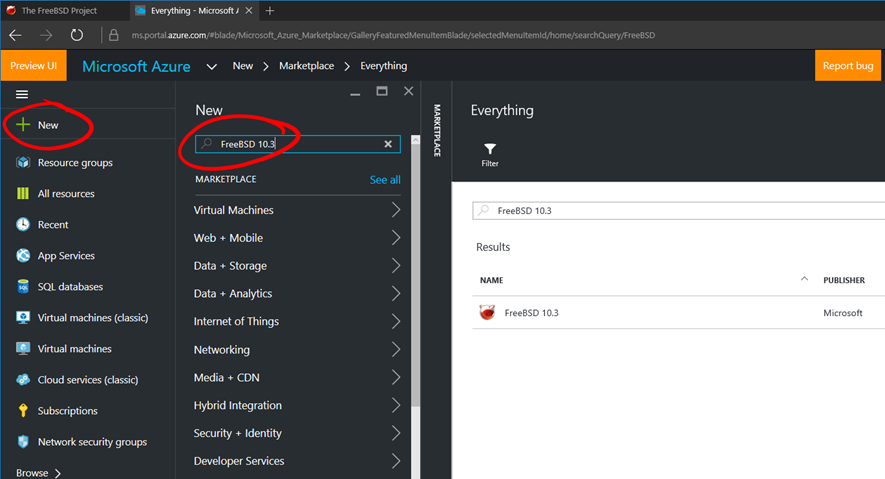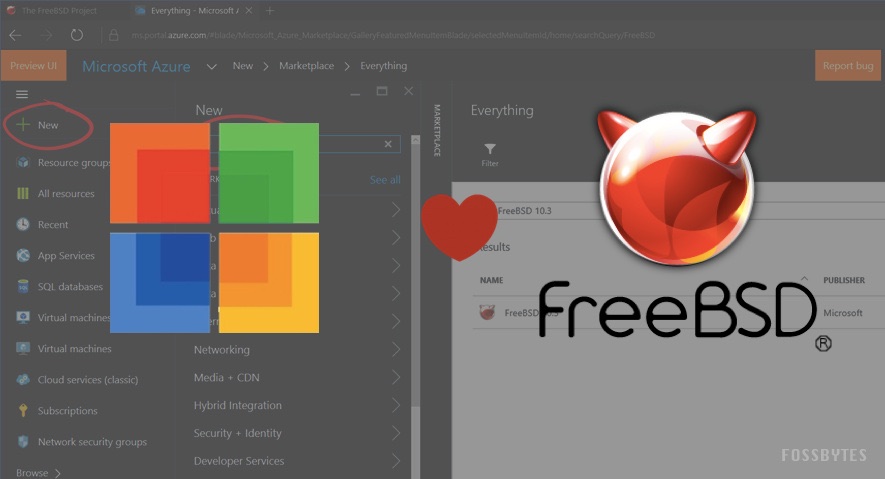Microsoft has made its own version of FreeBSD
A custom version of the FreeBSD 10.3 image is now available in Azure.

Microsoft has long been working closely with free software, in particular, with various Linux distributions. Now the company has created a custom version of FreeBSD, adding this OS to the Azure Marketplace. The company said it was testing, releasing and servicing the OS image so that customers can work with FreeBSD in Azure. Microsoft Azure implements two cloud models - platform as a service (PaaS) and infrastructure as a service (IaaS). The operability of the Windows Azure platform provides a network of global data centers Microsoft.
')
The company does not plan to work on its version of FreeBSD alone. According to Microsoft, "most of the additions we made to the core of FreeBSD 10.3 relate to network performance and storage ... any user who has downloaded FreeBSD 10.3 from the FreeBSD Foundation resource will receive these changes added to the OS." The company will create custom images of all subsequent versions of FreeBSD released by the FreeBSD Foundation. Subsequent kernel changes will also be related to data storage, plus the company continues to add new Hyper-V features to its OS version.
Hyper-V is a hardware virtualization system for hypervisor-based x64 systems. The beta version of Hyper-V was included in the x64 version of Windows Server 2008, and the final version (automatically through Windows Update) was released on June 26, 2008.
Why did the corporation take up FreeBSD at all? According to one of the developers, many of the configured Virtual Appliances templates (Virtual Appliances) are based on the FreeBSD operating system. Virtual Appliances suppliers include companies such as Citrix Systems, Array Networks, Stormshield, Gemalto, and Netgate. Thanks to cooperation with these companies, we managed to create our own version of the image of this OS. With the release of the image, the company's work with partners does not stop, over time, new features and functions will be added. This job took the company two whole years.

As can be seen in the screenshot in the announcement, the publisher of the FreeBSD image is Microsoft, not the FreeBSD Foundation. The reason is that the latter depends on the contributions of individual members of the community, including not only individual developers, but also companies that create their own FreeBSD solutions. Microsoft has decided to independently develop, test and maintain their images of this OS. So it turns out more efficiently, and Microsoft customers get the finished product faster than if the whole community works on it. Such a decision, as far as can be judged, suits the FreeBSD Foundation.
The FreeBSD OS itself is being developed as a complete operating system. The source code for the kernel, device drivers, and basic user programs (so-called userland), such as command shells, etc., are contained in a single version control tree. The OS is mainly used for building intranets and Internet networks, as well as for servers. The system is considered reliable, it implements efficient memory management, and also provides reliable network services. Due to the peculiarities of the license of the system, its code can be used not only in open-source software products, but also in proprietary projects, which Microsoft used.
Founder and Vice President of the FreeBSD Foundation, Justin T. Gibbs, commented on the situation as follows: “Placing a supported FreeBSD image in the Azure Marketplace is a significant achievement for both the FreeBSD community and Microsoft. We are grateful to the corporation for its contribution to the FreeBSD project. ”
The corporation also does not forget about previous versions of the OS. It is reported that despite the fact that the company works with FreeBSD 10.3, it provides some drivers for OS versions up to 8.4. Because of this, Azure users have the opportunity to upload their own FreeBSD VM image with an older version of the OS, with the ports provided by the company and the installed Azure VM Agent. True, the performance and capabilities of such distributions may vary. For example, the data transfer rate for FreeBSD 10.1 on a network with a bandwidth of 10 Gb / s was 2 Gb / s. But in version 10.3, this figure was already 9 Gbit / s. A list of supported Hyper-V versions of FreeBSD can be found here .
The fact that the company is going to create its own Linux distribution for use in the Azure data center Microsoft told back in September last year. In particular, it was said that Microsoft wants to build a software-configurable network, since it is difficult to adapt the "zoo" of equipment from different manufacturers with different operating systems.
In March of this year, Microsoft, together with Canonical, managed to integrate the Ubuntu operating system into Windows 10. And this is not a virtual machine, but an emulator-like system, where real-time Linux system calls are translated into Windows system calls. After checking, a number of users managed to launch some Linux desktop applications. Officially stated that there is no such possibility, but the user Reddit with the nickname w2qw found a way to launch “X” in Windows 10, which opens up the possibility of installing and working with VIM and Firefox.

Microsoft has long been working closely with free software, in particular, with various Linux distributions. Now the company has created a custom version of FreeBSD, adding this OS to the Azure Marketplace. The company said it was testing, releasing and servicing the OS image so that customers can work with FreeBSD in Azure. Microsoft Azure implements two cloud models - platform as a service (PaaS) and infrastructure as a service (IaaS). The operability of the Windows Azure platform provides a network of global data centers Microsoft.
')
The company does not plan to work on its version of FreeBSD alone. According to Microsoft, "most of the additions we made to the core of FreeBSD 10.3 relate to network performance and storage ... any user who has downloaded FreeBSD 10.3 from the FreeBSD Foundation resource will receive these changes added to the OS." The company will create custom images of all subsequent versions of FreeBSD released by the FreeBSD Foundation. Subsequent kernel changes will also be related to data storage, plus the company continues to add new Hyper-V features to its OS version.
Hyper-V is a hardware virtualization system for hypervisor-based x64 systems. The beta version of Hyper-V was included in the x64 version of Windows Server 2008, and the final version (automatically through Windows Update) was released on June 26, 2008.
Why did the corporation take up FreeBSD at all? According to one of the developers, many of the configured Virtual Appliances templates (Virtual Appliances) are based on the FreeBSD operating system. Virtual Appliances suppliers include companies such as Citrix Systems, Array Networks, Stormshield, Gemalto, and Netgate. Thanks to cooperation with these companies, we managed to create our own version of the image of this OS. With the release of the image, the company's work with partners does not stop, over time, new features and functions will be added. This job took the company two whole years.

As can be seen in the screenshot in the announcement, the publisher of the FreeBSD image is Microsoft, not the FreeBSD Foundation. The reason is that the latter depends on the contributions of individual members of the community, including not only individual developers, but also companies that create their own FreeBSD solutions. Microsoft has decided to independently develop, test and maintain their images of this OS. So it turns out more efficiently, and Microsoft customers get the finished product faster than if the whole community works on it. Such a decision, as far as can be judged, suits the FreeBSD Foundation.
The FreeBSD OS itself is being developed as a complete operating system. The source code for the kernel, device drivers, and basic user programs (so-called userland), such as command shells, etc., are contained in a single version control tree. The OS is mainly used for building intranets and Internet networks, as well as for servers. The system is considered reliable, it implements efficient memory management, and also provides reliable network services. Due to the peculiarities of the license of the system, its code can be used not only in open-source software products, but also in proprietary projects, which Microsoft used.
Founder and Vice President of the FreeBSD Foundation, Justin T. Gibbs, commented on the situation as follows: “Placing a supported FreeBSD image in the Azure Marketplace is a significant achievement for both the FreeBSD community and Microsoft. We are grateful to the corporation for its contribution to the FreeBSD project. ”
The corporation also does not forget about previous versions of the OS. It is reported that despite the fact that the company works with FreeBSD 10.3, it provides some drivers for OS versions up to 8.4. Because of this, Azure users have the opportunity to upload their own FreeBSD VM image with an older version of the OS, with the ports provided by the company and the installed Azure VM Agent. True, the performance and capabilities of such distributions may vary. For example, the data transfer rate for FreeBSD 10.1 on a network with a bandwidth of 10 Gb / s was 2 Gb / s. But in version 10.3, this figure was already 9 Gbit / s. A list of supported Hyper-V versions of FreeBSD can be found here .
The fact that the company is going to create its own Linux distribution for use in the Azure data center Microsoft told back in September last year. In particular, it was said that Microsoft wants to build a software-configurable network, since it is difficult to adapt the "zoo" of equipment from different manufacturers with different operating systems.
In March of this year, Microsoft, together with Canonical, managed to integrate the Ubuntu operating system into Windows 10. And this is not a virtual machine, but an emulator-like system, where real-time Linux system calls are translated into Windows system calls. After checking, a number of users managed to launch some Linux desktop applications. Officially stated that there is no such possibility, but the user Reddit with the nickname w2qw found a way to launch “X” in Windows 10, which opens up the possibility of installing and working with VIM and Firefox.
Source: https://habr.com/ru/post/372357/
All Articles